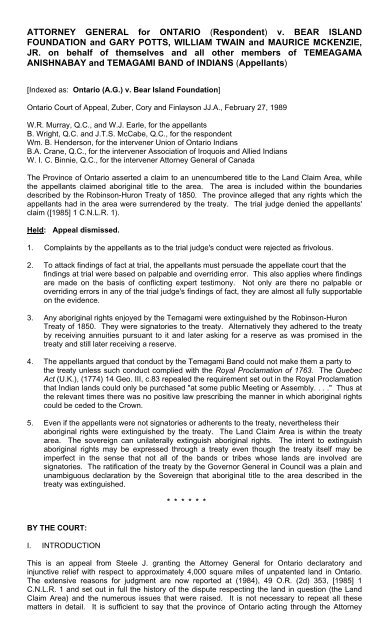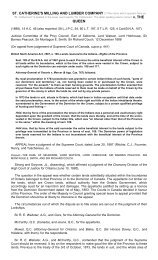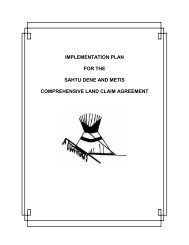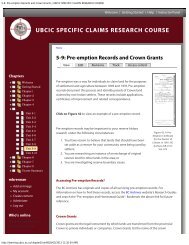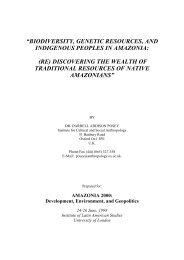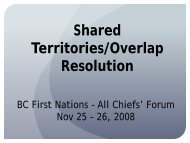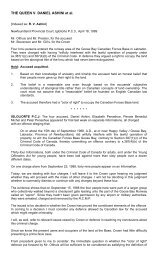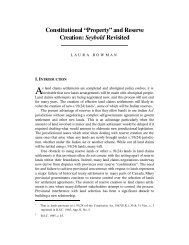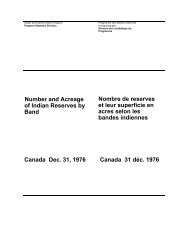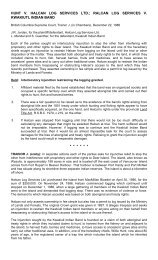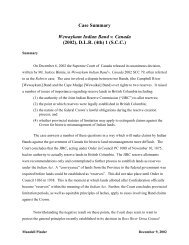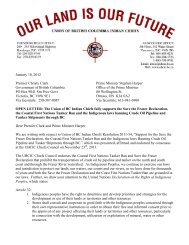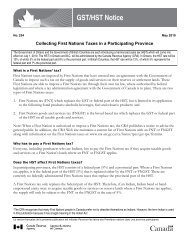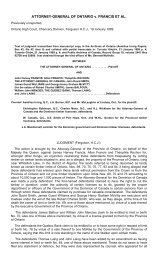ATTORNEY GENERAL for ONTARIO (Respondent) v. BEAR ...
ATTORNEY GENERAL for ONTARIO (Respondent) v. BEAR ...
ATTORNEY GENERAL for ONTARIO (Respondent) v. BEAR ...
Create successful ePaper yourself
Turn your PDF publications into a flip-book with our unique Google optimized e-Paper software.
<strong>ATTORNEY</strong> <strong>GENERAL</strong> <strong>for</strong> <strong>ONTARIO</strong> (<strong>Respondent</strong>) v. <strong>BEAR</strong> ISLANDFOUNDATION and GARY POTTS, WILLIAM TWAIN and MAURICE MCKENZIE,JR. on behalf of themselves and all other members of TEMEAGAMAANISHNABAY and TEMAGAMI BAND of INDIANS (Appellants)[Indexed as: Ontario (A.G.) v. Bear Island Foundation]Ontario Court of Appeal, Zuber, Cory and Finlayson JJ.A., February 27, 1989W.R. Murray, Q.C., and W.J. Earle, <strong>for</strong> the appellantsB. Wright, Q.C. and J.T.S. McCabe, Q.C., <strong>for</strong> the respondentWm. B. Henderson, <strong>for</strong> the intervener Union of Ontario IndiansB.A. Crane, Q.C., <strong>for</strong> the intervener Association of Iroquois and Allied IndiansW. I. C. Binnie, Q.C., <strong>for</strong> the intervener Attorney General of CanadaThe Province of Ontario asserted a claim to an unencumbered title to the Land Claim Area, whilethe appellants claimed aboriginal title to the area. The area is included within the boundariesdescribed by the Robinson-Huron Treaty of 1850. The province alleged that any rights which theappellants had in the area were surrendered by the treaty. The trial judge denied the appellants'claim ([1985] 1 C.N.L.R. 1).Held: Appeal dismissed.1. Complaints by the appellants as to the trial judge's conduct were rejected as frivolous.2. To attack findings of fact at trial, the appellants must persuade the appellate court that thefindings at trial were based on palpable and overriding error. This also applies where findingsare made on the basis of conflicting expert testimony. Not only are there no palpable oroverriding errors in any of the trial judge's findings of fact, they are almost all fully supportableon the evidence.3. Any aboriginal rights enjoyed by the Temagami were extinguished by the Robinson-HuronTreaty of 1850. They were signatories to the treaty. Alternatively they adhered to the treatyby receiving annuities pursuant to it and later asking <strong>for</strong> a reserve as was promised in thetreaty and still later receiving a reserve.4. The appellants argued that conduct by the Temagami Band could not make them a party tothe treaty unless such conduct complied with the Royal Proclamation of 1763. The QuebecAct (U.K.), (1774) 14 Geo. III, c.83 repealed the requirement set out in the Royal Proclamationthat Indian lands could only be purchased "at some public Meeting or Assembly. . . ." Thus atthe relevant times there was no positive law prescribing the manner in which aboriginal rightscould be ceded to the Crown.5. Even if the appellants were not signatories or adherents to the treaty, nevertheless theiraboriginal rights were extinguished by the treaty. The Land Claim Area is within the treatyarea. The sovereign can unilaterally extinguish aboriginal rights. The intent to extinguishaboriginal rights may be expressed through a treaty even though the treaty itself may beimperfect in the sense that not all of the bands or tribes whose lands are involved aresignatories. The ratification of the treaty by the Governor General in Council was a plain andunambiguous declaration by the Sovereign that aboriginal title to the area described in thetreaty was extinguished.* * * * * *BY THE COURT:I. INTRODUCTIONThis is an appeal from Steele J. granting the Attorney General <strong>for</strong> Ontario declaratory andinjunctive relief with respect to approximately 4,000 square miles of unpatented land in Ontario.The extensive reasons <strong>for</strong> judgment are now reported at (1984), 49 O.R. (2d) 353, [1985] 1C.N.L.R. 1 and set out in full the history of the dispute respecting the land in question (the LandClaim Area) and the numerous issues that were raised. It is not necessary to repeat all thesematters in detail. It is sufficient to say that the province of Ontario acting through the Attorney
General asserted a claim to an unencumbered title to the Land Claim Area. The appellants claimthat the title to the Land Claim Area is burdened by aboriginal rights possessed by the TemagamiIndian Band. The learned trial judge denied the appellants' claim and rested his judgment on anumber of alternative grounds. The appellants take issue with all of his conclusions and ask thatthe judgment be reversed.It should be made plain what is in issue in this appeal. The subject matter of the dispute is the titleto land. The province takes the position that its ownership of the land in question is unencumberedby any aboriginal rights of the appellants. The appellants, of course, argue the contrary. What isnot at stake in this appeal is the right of the appellants to claim compensation or to claim any otherbenefit that may accrue to them as an unfulfilled obligation under the Robinson-Huron Treaty.II.THE ISSUESA. Problems at TrialCounsel <strong>for</strong> the appellants filed a volume of factum and written argument entitled "Problems atTrial." The first paragraph sets <strong>for</strong>th the substance of the complaint.The following is a compilation of miscellaneous incidents during trial, evidentiary rulings,remarks by Steele J. both during the trial and in his reasons <strong>for</strong> Judgment, which in thesubmission of the Appellants reflect a hostility of mind on the part of the trier of fact towardthe Defendants at trial sufficient to call into question whether Steele J. impartially andjudicially weighted the evidence be<strong>for</strong>e him in reaching his findings of facts and credibility.The allegation is astonishing in light of the comments that follow in the factum about counsel at trial(not either of the counsel who appeared on the appeal). It states that he was inexperienced,presented the evidence in excessive detail, cross-examined his own witnesses, engaged in lengthylines of questioning which were of dubious relevance, and attempted to argue the case whileintroducing evidence. At the close of evidence, he filed a written argument which dealt not at allwith the evidence be<strong>for</strong>e the trial judge but was a treatise on aboriginal rights prepared prior to thetrial. Counsel on appeal stated that trial counsel's personal involvement in his clients' case causedhim to make certain inappropriate and disrespectful remarks about the court and the judicialsystem.Notwithstanding this, it is submitted in this court that friction developed between counsel and thetrial judge and thatThe understandable irritation shown by Steele J. towards counsel <strong>for</strong> the defendants isevidence of possible bias, and raises a reasonable apprehension that Steele J. may nothave considered the merits of the defendants' case as impartially as he might otherwisehave done.The trial was of exceptional length and complexity. There were 120 sitting days and more than3,000 exhibits were filed. On the appeal, which lasted 14 hearing days, appellants' counsel argued<strong>for</strong> 8 days, including reply. The respondent, the Attorney-General <strong>for</strong> Ontario, argued <strong>for</strong> the bestpart of 4 days. The rest of the time was taken up by the interveners.The case on appeal was argued largely on the facts by appellants' counsel. The appellants filedwith the court 7 volumes of factum and written argument, the respondent filed 5 volumes and thethree interveners filed 1 volume each. The court was referred to other material which was filed inaddition and to substantial passages from the evidence and exhibits. In particular, with referenceto the criticism of the trial judge, we were referred separately to all his so-called interjections, all hisrulings on evidence and to all his findings in the judgment to which exception was taken on thegrounds of possible bias.We have made a careful review of all this material and are of the opinion that the trial judgeshowed exceptional courtesy to and patience with a very inexperienced counsel who insisted onpresenting masses of evidence, much of which was of marginal relevance. The trial judge bentover backwards to assist counsel and was well aware of the evidentiary problems facing theTemagami Band in attempting to reconstruct an ancestral history that it alleged went back prior to1763. We can only say that having conducted this review, we have no hesitation in holding that thecomplaints as to the trial judge's conduct are frivolous and not worthy of further comment.B. Findings of Fact
We note that in attacking the findings of fact of the trial judge, appellants' counsel in the factum andwritten argument, and in oral submissions, stated on a number of occasions that "the judgment isperverse to the evidence." Whatever was intended by the use of this language, it is clear that theburden on the appellants was to persuade this court that the trial judge's findings were based onpalpable and overriding error. The test is set out by Ritchie J. in Stein v. The Ship "Kathy K",[1976] 2 S.C.R. 802 at 806, 808.I think that under such circumstances the accepted approach of a court of appeal is to testthe findings made at trial on the basis of whether or not they were clearly wrong rather thanwhether they accorded with that court's view of the balance of probability.…These authorities are not to be taken as meaning that the findings of fact made at trial areimmutable, but rather that they are not to be reversed unless it can be established that thelearned trial judge made some palpable and overriding error which affected his assessmentof the facts.The rule applies not only where findings are based on credibility but also where findings are madeon the basis of conflicting expert testimony. See N.V. Bocimar S.A. v. Century Insurance Co. ofCanada (1987), 76 N.R. 212 at 213 (S.C.C.) per Le Dain J.:The Court of Appeal took the position that because of the nature of the evidence in thiscase, which consisted of expert testimony and documentary evidence, the court, to use itsown words, was "almost in the position of conducting the trial de novo and making our ownassessment of the evidence." I cannot agree. The limits to the scope of appellate review ofthe findings of the fact by a trial court, which were affirmed by this court in Stein v. The Ship"Kathy K," [1976] 2 S.C.R. 802, and other decisions, also apply in my opinion to the reviewof the findings of a trial court based on expert testimony. . . .See also, Lewis v. Todd, [1980] 2 S.C.R. 694; Joseph Brant Memorial Hospital v. Koziol, [1978] 1S.C.R. 491; Schreiber Brothers Ltd. v. Currie Products Ltd., [1980] 2 S.C.R. 78; Joyce v. Yeomans,[1981] 2 All E.R. 21 (C.A.); and Beaudoin-Daigneault v. Richard, [1984] 1 S.C.R. 2.The trial judge's reasons are exhaustive, comprising 284 pages exclusive of schedules. He hasprovided a useful table of contents and his reasons reflect a meticulous and well-organizedapproach to the problems be<strong>for</strong>e him. There are no palpable or overriding errors in any of hisfindings of fact.In addition to the findings that were essential to the issues be<strong>for</strong>e him, the trial judge paid counsel<strong>for</strong> the Temagami Band the courtesy of dealing extensively with matters of some historical andcultural interest but of little relevance to the case. As to the history of the band, the trial judgeexpressed disappointment that so little of the evidence was given by band members. Chief Pottswas the principal Indian witness to give oral history and his testimony was not oral history in thetraditional sense. His own family did not arrive in the Land Claim Area until 1901, and his principalsource of in<strong>for</strong>mation was not his parents and grandparents. Instead, he gave evidence that wasthe result of his research and that which he had learned from other members of the band who werenot called as witnesses. His evidence was not, in any sense, the best evidence available and therewere available, older band members who could recount oral tradition. Chief Potts' testimony wasnot similar in quality to the type presented in other cases where oral history has been admitted: see<strong>for</strong> example, Re Paulette's Application to File a Caveat (1973), 42 D.L.R. (3d) 8 (N.W.T.S.C.).We feel that having regard to the quality of the evidence, the fact that there are substantial gaps inthe history of the Temagami Band, that its relationship with sovereign governments of the day isnot well documented during some periods of time, and after acknowledging the need to draw broadinferences, weigh conflicting theories and to some extent speculate, we are of the opinion that thetrial judge made a remarkable analysis of the evidence. Not only do his findings of fact not amountto nor constitute palpable and overriding error, they are almost without exception fully supportableon the evidence.C. Nature of Aboriginal RightsA threshold issue in this case is whether or not the Temagami Band had any aboriginal rights in theLand Claim Area. In his reasons <strong>for</strong> judgment, Steele J. said in his summary of findings at pp.372-73 [pp.20-21 C.N.L.R.]:
With respect to the area south of the Height of Land, I find that the land is governed by theRoyal Proclamation of 1763. I find that the intent and effect of that proclamation is to createaboriginal rights that are personal and usufructuary and dependent upon the pleasure of theCrown. The limited dependent nature of these rights is not altered by the fact that theCrown may, as a matter of expediency or goodwill, have chosen to enter into treaties withthe Indians. The relevant date <strong>for</strong> determining aboriginal rights is 1763. With respect to thesmall area north of the Height of Land, I find that the land was not covered by the RoyalProclamation of 1763 but that the rights of the Indians and Crown at common law are in allways the same as in proclamation lands, except that the relevant date <strong>for</strong> determiningaboriginal rights is the coming of settlement.Second, I will deal with the nature of the aboriginal rights exercised in the area south of theHeight of Land in 1763, and in the area north of the Height of Land at the same time, thoughI need not and cannot determine, <strong>for</strong> the latter, the actual time of the coming of settlement. Iconclude that the Royal Proclamation and common law gave to the Indians only theaboriginal right to continue using the lands <strong>for</strong> the purposes and in the manner enjoyed in1763, and not the right to any new uses to which they might subsequently put the land. I listthe traditional uses <strong>for</strong> basic survival and personal ornamentation existing as of 1763.Third, I will deal with the entitlement of the defendants to aboriginal rights in the Land ClaimArea. I find that the defendants have failed to prove that their ancestors were an organizedband level of society in 1763; that, as an organized society, they had exclusive occupation ofthe Land Claim Area in 1763; or that, as an organized society, they continued to exclusivelyoccupy and make aboriginal use of the Land Claim Area from 1763 or the time of the comingof settlement to the date the action was commenced.The appellants and the interveners, including the Attorney General of Canada, all take issue withall or some parts of the trial judge's conclusions on this issue. The appellants do not accept thecritical dates used by the trial judge <strong>for</strong> ascertaining rights or the effect of the Royal Proclamation.It is argued that the trial judge imposed too high a standard of social organization as a prerequisite<strong>for</strong> the acquisition of aboriginal rights. It is further argued that he imposed too high a standard ofexclusive use of the lands in question. Lastly, it is said that he imposed too high an evidentiaryburden on the defendants to prove facts necessary to demonstrate aboriginal rights.In light of the conclusions we have reached with respect to the effect of the Robinson-HuronTreaty, it is not necessary to deal with these arguments. We express no opinion on these issuesand are not to be taken as necessarily approving the views of Steele J. in these matters. We areprepared to assume, without deciding, that the Temagami Indians in 1850 enjoyed aboriginal rightsto at least some part of the Land Claim Area and that these rights extended to the use andoccupation of the lands in the traditional ways of a band.D. Extinguishment of RightsThis court does not feel that it is necessary to deal with every issue put to the trial judge. We aresatisfied that any aboriginal rights enjoyed by the Temagami were extinguished by the Robinson-Huron Treaty of 1850. The Temagami were signatories to the treaty. Alternatively they adhered tothe treaty by receiving annuities pursuant to it and later asking <strong>for</strong> a reserve as was promised in thetreaty and still later receiving a reserve. Finally, their rights were extinguished, even if theTemagami were not signatories or adherents, because the treaty was at least a unilateral act ofextinguishment by the sovereign authority.In support of these conclusions, we are content to rely on the following restricted chronology ofevents which we derive from the findings of the trial judge and our own examination of the evidencethat supports those findings. Because the exhibits and the transcript of evidence use differentterminology <strong>for</strong> Indian bands, names and places, <strong>for</strong> convenience, we have adopted that spellingused by Steele J., even to the point of changing original spellings and names in historicaldocuments.1. Extinguishment by signing the Robinson-Huron Treaty(a)History of the Temagami BandIt is difficult to establish on the evidence when the Temagami Indians became an organized band.There is a reference in the Jesuit Relations of 1640 to an organized band around Lake Temagamicalled the Outemagami, but its authenticity as the original Temagami Band is doubtful. In any
event that band appears to have been scattered by Iroquois incursions, disease, or becauseresidents of the area became associated with other Indian groups.Dr. F.G. Speck, an anthropologist, studied the Temagami Indians in 1913 and thought them to be aband on that date. He stated in his Memoir No.70, Family Hunting Territories and Social Life ofVarious Algonkian Bands of the Ottawa Valley, that. . . evidences seem to support the assumption that these people are part of a steadynorthward drift of Ojibwa-speaking tribes from the Great Lakes. The Temagami themselvessay that their ancestors came from near Sault Ste. Marie.He stated that the Temagami people needed to seek new hunting grounds in order to replace theirown territory in the Great Lakes region then being despoiled by "the white people."The timing of the arrival of the Temagami Indians at Lake Temagami in the Land Claim Area is notclear. The reason <strong>for</strong> this appears to be that they were not recognized as a distinct band until theearly nineteenth century. They are not mentioned in any records from the trading post on LakeTemiskaming during the French regime (i.e. prior to 1760) despite the fact that other bands arelisted, including the Nipissings. As late as 1834, a list of Indians compiled at the Hudson BayCompany post at Lake Temagami made no reference to them and appeared to include them with"Lake Nipissing Indians." They are first referred to as Temagami Indians in the Imperial presentlists of 1849 and 1850. The giving of presents was a longstanding practice initiated by the Englishafter the conquest. One of its practical results was to obtain an annual census of the Indianpopulation.A complicating factor is that contemporary documents record <strong>for</strong>est fires in the summer of 1846 inthe vicinity of Lake Temagami that were devastating, destroying <strong>for</strong>ests and driving game away.Some Indians died of starvation and epidemics of disease. It is thought that some moved away tothe west to find more hospitable territory. Certainly the Hudson Bay post at Lake Temagami wasoccupied only sporadically during the years 1846 to 1857. At least one expert witness, Dr. CharlesBishop, fixed the date of the establishment of the Temagami Indians as a band at 1857, coincidingwith the re-opening of this post. His theory was that once people started trading regularly at a postthey ceased to identify with their <strong>for</strong>mer bands and developed a sense of uniqueness and groupcohesiveness.The significance of this narrative becomes apparent when we look at the circumstancessurrounding the signing of the Robinson-Huron Treaty of 1850. Counsel <strong>for</strong> the Attorney General<strong>for</strong> Ontario submits, and the trial judge found as a fact, that the Temagami Indians wererepresented at the signing by an Ojibwa chief called Tawgaiwene. Counsel <strong>for</strong> the appellantssubmits that the band's chief man was Peter Nebenegwune who was not present at the signing nordid he ever become party to the treaty. In assessing the credibility of the two positions, it is usefulto keep in mind the structure of the Temagami Indian group in 1850. If it was a band, itscomposition appears to have been fluid and its territorial hunting grounds not well defined. It mightbe <strong>for</strong> this reason that its members were content to be represented by Chief Tawgaiwene at thetreaty signing. It would certainly explain why Robinson and those advising him would not haveexpected the Temagami Band to be represented separately.(b)Events precipitating the Robinson-Huron TreatyEarly in 1850 there was an attack by Indians on the property of the Québec Mining Companyarising out of grievances the Ojibwa had with white settlers exploiting mining claims on lands theIndians regarded as their own. Two Ojibwa chiefs, Nebenaigoching of Sault St. Marie andShinguacouse of Garden River were arrested. By order-in-council of April 16, 1850, theHonourable William B. Robinson was instructed by the Executive Council of the province ofCanada "to negotiate <strong>for</strong> the extinction of the Indian title to the whole territory on the north andnortheastern coasts of Lakes Huron and Superior. . . ."The Executive Council had be<strong>for</strong>e it the Report of Commissioners Alexander Vidal and T.G.Anderson who had been appointed by an order-in-council of August 7, 1849. . . to visit the Indians on the north shores of Lakes Huron and Superior, <strong>for</strong> the purpose ofinvestigating their claims to the territory bordering on those Lakes, and obtaining in<strong>for</strong>mationon various points relative to their proposal to surrender their lands to the Crown . . . .A map appended to the report shows Lake Huron and to the north and east, Lakes Temagami andNipissing, and the Sturgeon and French rivers. Robinson had a copy of this report prior to the
treaty discussions and commented in his diary that it was useful and valuable.Pursuant to his instructions, Robinson went to Garden River on May 1, 1850, where he met with sixchiefs, and discussed a treaty. His diary records that he told them that he could not proceedunless all the interested chiefs were present. It is clear from Robinson's dairy that he wanted toobtain a surrender of the lands of the Indians and that the chiefs present, who were from SpanishRiver, Sault Ste. Marie and Garden River, all agreed that this was to be the object of the treatydiscussions. He then told them that he would meet with them at Manitowaning on Manitoulin Islandin August when they received their traditional Imperial presents. The chiefs protested thatManitoulin Island was too far away and suggested Garden River.Robinson acceded to this suggestion and asked the chiefs and officials of the Hudson BayCompany to advertise the treaty meeting. In August of 1850 he travelled to Penetanguishene andManitoulin Island where the Imperial presents were being handed out. Captain George Ironside,who was to play an important role in matters relating to the treaty, was left at Manitoulin Island tolook after the giving of the Imperial presents. There were some 2,400 Indians celebrating theoccasion. Ironside later arrived at Garden River on the steamship Gore on September 2, 1850 withChief Tawgaiwene, his son Jocko, and other Indians. The council meeting, at which 21 chiefs werepresent, commenced on September 5.It is apparent that Robinson wanted chiefs of the bands inhabiting the two areas around LakeSuperior and Lake Huron as signatories to a treaty. Lake Superior was no problem. He quicklymade an agreement with Chief Joseph Peau de Chat and the other Lake Superior chiefs and theRobinson-Superior Treaty was signed on September 7, 1850. Some difficulty arose with the LakeHuron Indians because Shinguacouse of Garden River wanted more money. Nebenaigoching alsowas difficult to persuade, but on September 9, 1850, the Robinson-Huron Treaty was signed by 18chiefs including Tawgaiwene.Robinson had originally proposed to pay the treaty money to the chiefs on behalf of their respectivebands, but at the request of the chiefs he undertook the distribution of the moneys himself. To thisend, he travelled on September 10 to Sault. Ste. Marie to pay Nebenaigoching's band, onSeptember 11 to Garden River to pay Shinguacouse's band and others, and on September 13 toManitoulin Island to pay Chiefs Tawgaiwene, Dokis, Maisquawzo and "head man" PeterNebenegwune. Finally, he went to Penetanguishene on September 16 where he obtained thesignatures of the chiefs representing this area and paid them their treaty money. It is worthy ofnote that if Robinson had regarded Nebenegwune's signature to the treaty as necessary, he couldhave obtained it at Manitoulin Island when he paid the treaty money, a procedure he followed withthe chiefs at Penetanguishene.It is evident that Robinson was satisfied that he was dealing with what the treaty described as "theprincipal men of the Ojibwa Indians" inhabiting the area described in the treaty. These were chiefsrepresenting Indians from Sault Ste. Marie, Garden River, Penetanguishene, Lake Nipissing andFrench River.The Temagami Indians were considered to be Lake Nipissing Indians. Chief Mishequanga fromFrench River signed the treaty. Chief Dokis, Shabokishick, Maisquawzo and Tawgaiwene,described in the treaty as from or near Lake Nipissing, signed the treaty. Their signatures werebinding on all of the Indian bands in the area including the Temagami Indians. PeterNebenegwune, by his acceptance of $25 at Manitoulin Island, acknowledged that his band, if it wassuch, was bound by the treaty. He was described as a "head man" on voucher No.11 witnessed byIronside and Robinson. He received the same amount as Chiefs Tawgaiwene, Dokis, andMaisquawzo.(c)The role of TawgaiweneThe trial judge found as a fact that Tawgaiwene signed the treaty on behalf of Nebenegwune andthe Temagami Indians, whether they <strong>for</strong>med a band or not. Counsel <strong>for</strong> the Temagami Bandvigorously disputed this finding and maintained that Tawgaiwene did not represent anyone buthimself at Garden River. This is a difficult submission to accept because it assumes that Robinsonwould be prepared to pay moneys and grant a reserve to a chief whose signature could bind noone in the territory covered by the treaty. It also conflicts with the recollection of Tawgaiwene'ssons Jocko who continued his interest in the Temagami Band. In a letter dated January 19, 1880,he made the following statement concerning his father's involvement in the Robinson-HuronTreaty:My late Father I.B. Tawgaiwene representing the Band of Wanapitei between Nipissing and
White Fish Lake had marked the limits of a reserve on the lake of that name.It is clear that he was representing some band covered by the treaty other than his own family atManitoulin Island.Tawgaiwene was well known to the Department of Indian Affairs. On March 25, 1850, Ironsidereported to Colonel Bruce, Superintendent General of Indian Affairs, about a claim thatTawgaiwene had with respect to lands on either side of Goderich on Lake Huron (outside the treatyarea) and advised that Tawgaiwene resided at Wequamikong on Manitoulin Island. This letter wasreferred by Bruce to Superintendent Clench of Indian Affairs on May 4, 1850. On June 28, 1850Clench reported on the claim and advised thatThe Ojibwa of Port Sarnia feel disposed to recognize Tawgaiwene as a brother entitled toshare in the Reserve and Annuity from the time he shall establish himself in their midst.This is a reference to a different treaty: the Huron Tract Treaty of 1827. Bruce received this reporton July 6, 1850. Bruce was at Sault Ste. Marie from August 25-30 and conferred with Robinson ona number of occasions.In August of 1850, Ironside had gone to Manitoulin Island. We know that Nebenegwune was therebecause he was on the list of those receiving the Imperial presents. When Ironside left, he broughtTawgaiwene and his son Jocko with him, but not Nebenegwune. We know that Nebenegwune wasstill at Manitoulin Island on September 13 because his name appears on a voucher as receivingpayments under the treaty along with Tawgaiwene and others.The theory that Tawgaiwene represented nobody but himself makes little sense. If his claim waswith respect to lands near Goderich, why was he present at Garden River with the activeassistance of Ironside? Why would Robinson and Ironside permit him to participate as a signatoryin the treaty if his signature bound no one? Why was he given a reserve at Lake Wanapitei whenhe lived at Manitoulin Island and at no time took up residence at the reserve?There can be no doubt on the contemporary evidence available that Robinson and the governmentof the day regarded Tawgaiwene as the spokesman <strong>for</strong> those Nipissing Indians that includedNebenegwune and the Temagami Indians even though, while an Ojibwa, he was not of a Nipissingareaband himself. In the schedule of reservations appended to the treaty, Chief Shabokishick'sreservation is described as being on Lake Nipissing and "Tawgaiwene and his Band" receive areservation at Lake Wanapitei "near Lake Nipissing."It may well be that Robinson relied upon Tawgaiwene as one falling within the description providedin the Vidal-Anderson Report as a chief possessed of superior in<strong>for</strong>mation, intelligence or cunningwho had the ability and initiative to act <strong>for</strong> others. What is clear is that there is no contemporaryevidence of Nebenegwune or any members of the Temagami Band attempting to disassociatethemselves from Tawgaiwene's actions at Garden River. On the contrary, as we shall see, there iscontemporary evidence of acknowledgement by Nebenegwune and the band that they wereentitled to the treaty payments as adherents to the treaty.We should also consider the attitude of the other chiefs present at Garden River. It is difficult tobelieve that they would permit Tawgaiwene to play such an active role if he was not recognized bythem as a chief with representation in the treaty area. He must have spoken <strong>for</strong> the Nipissing andFrench River Indians when he, along with only Peau de Chat and Shinguacouse were the chiefspermitted to address the Governor General, Lord Elgin, on September 3, 1850. Peau de Chatcertainly spoke <strong>for</strong> the Lake Superior Indians, and Shinguacouse represented all the Indians in theSault Ste. Marie area in the absence of the ailing Nebenaigoching. The Penetanguishene chiefswere not at Garden River. Since both Dokis and Shabokishick were Nipissing chiefs andMishequanga was a French River chief, all three of whom were there and signed the treaty, it isstrange that they would permit Tawgaiwene to put himself <strong>for</strong>ward as representing their bands if hehad no authority to do so.Counsel <strong>for</strong> the Temagami Band makes the point that there was no proper census of the Indiansaround Lakes Nipissing and Temagami and it was really not contemplated that they would besignatories to the treaty. This may explain some of the wording of the treaty. The last paragraph ofthe text provided <strong>for</strong> an additional £160 "in consequence of the Indians inhabiting French River andLake Nipissing having become parties to this treaty." Perhaps the arrival of these Indians was nottotally expected, but they were clearly within the treaty area and Robinson wanted as manysignatures as he could get.
The grouping of the signing is significant. Tawgaiwene signed the treaty fifth followed immediatelyby Shabokishick and Dokis. There is added as an apparent afterthought, "and also ChiefMaisquawzo" and other named chiefs. Chief Maisquawzo is the only signatory to the treaty whodid not receive a reserve. He was Tawgaiwene's brother-in-law. At the time of the treaty he wasliving on Manitoulin Island. He is listed as having received Imperial presents from 1848 to 1852.He died on December 17, 1853 at Wequamikong on Manitoulin Island where Tawgaiwene and hisson Jocko still lived.An examination of the accounting by Robinson on September 26, 1850, to the ExecutiveCommittee of the Council and hence to the Legislative Assembly is instructive. It shows as paid to"Nebenegwune and Band" on September 13 the sum of £112 5s and refers to voucher No.11.Voucher No.11 has this total broken down into dollars and includes in the following order:Nebenegwune (head man) $25.00Tawgaiwene, Chief $25.00Dokis (Near Lake Nipissing) head man $25.00Maisquawzo, Chief $25.00Shabokeshick's payments are shown on voucher No.12 and Mishequanga's on voucher No.6. It issignificant that all four chiefs and head men on voucher No.11 received the same amount. It alsowill become significant that the voucher represents payments to 96 persons. The court was takenin detail through payments made under the treaty in cash and kind until they ceased so far asNebenegwune was concerned in 1856. The relationship among these four, the size of the band,and the gross amount paid seem to remain constant. In particular, there appears to be always aclose connection between Tawgaiwene and Nebenegwune so far as Ironside at least wasconcerned. In two vouchers <strong>for</strong> payments under the treaty, Tawgaiwene and Nebenegwune arebracketed and shown as being from Wanapitei, the location of the reservation provided toTawgaiwene by the treaty.As indicated earlier, Tawgaiwene had no connection with the treaty area except <strong>for</strong> his residenceon Manitoulin Island. He had no association with Lake Wanapitei but there is evidence that theTemagami Band of Nebenegwune did. In 1880, Charles Skene, the local officer of Indian Affairs atParry Sound, was asked by his superior to determine from the then chief of the Temagami Band,Chief Tonene, what were the hunting grounds of his band. Tonene wag the son-in-law ofNebenegwune. From a department map provided by Skene, Tonene indicated the band's huntinggrounds which clearly showed Lake Wanapitei and Lake Temagami. Skene then drew a map ofthose hunting grounds and in turn showed it to his guide Gilbert Pawis, a signatory to the treaty,who made some corrections in it. He showed it to "several of the Lake Nipissing Indians who knowthe country" and they agreed with its accuracy. All were in agreement that Lake Wanapitei wasincluded in the Temagami Band hunting grounds.On the basis of the <strong>for</strong>egoing facts we fail to see how it can be said that the trial judge made apalpable and overriding error in coming to the conclusion that the Temagami were signatories tothe Robinson-Huron Treaty. On the contrary, we think he was right in so concluding.2. Extinguishment by Adhesion to the Robinson-Huron TreatyAlthough Steele J. Found that the Temagami Band was bound by the Robinson-Huron Treaty as asignatory, he went on to find that even if the Temagami Band was not a signatory it was boundbecause the band later became a party or adhered to the treaty.(a)Annuity paymentsThe evidence is clear that on September 13, 1850, Nebenegwune was paid pursuant to the treaty.Although there is some evidence that the payments may have extended <strong>for</strong> a longer period of time,it is clear that at least until 1856 the Temagami Band was paid in either money or in goods througheither Nebenegwune or Tawgaiwene pursuant to the treaty. Following 1856 or thereabouts, thereare no government records that anyone on behalf of the Temagami Indians came to collect thetreaty money.In 1864, however, Kakake, then chief of the Temagami Band, wrote to the local officer of IndianAffairs at Manitowaning asking <strong>for</strong> payments that he had always received when Ironside was alive.It does not appear that payments were made. Later, in the 1 870s Chief Tonene of the Temagamiapproached the local officer of Indian Affairs at Parry Sound asking that the band again be paid themoney that it had received in earlier years. Again, no action resulted from this request. It appearsthat by about 1880 the officials of the Department of Indian Affairs had concluded that the
Temagami Band had not been a party to the Robinson-Huron Treaty. This conclusion was basedon the records available to them. It now appears that their records were incomplete. A furthercomplication appears to have been Confederation in 1867 and the transfer of Indian Affairs to thegovernment of Canada. We were referred to a considerable body of material demonstrating areluctance on the part of both provincial and federal governments to honour their respectiveobligations in this field.In any event, on August 26, 1882, J.C. Phipps, the local officer of Indian Affairs at ManitoulinIsland, wrote to Skene stating:The Temagami Indians through Jocko Tawgaiwene have applied to be placed in the list ofannuitants under the Robinson Treaty, and have sent the enclosed census of the bandamounting to 89 souls --- Jocko says he thinks there are three families yet to be added.Finally, in 1883, the Department of Indian Affairs, on the assumption that the Temagami Band hadnot been a party to the Robinson-Huron Treaty, decided, in view of the willingness of theTemagami to come into the treaty, that it would add them to the annuity pay list. The annuity wasthen paid to the Temagami Band in 1883 and every year thereafter until 1979. In 1979 annuitycheques were returned because of the position taken by the band in this case, i.e. that they hadnever surrendered their aboriginal rights.(b)Requests <strong>for</strong> a reserveIn addition to the issue of annuity payments, the Temagami Band pressed the Department of IndianAffairs <strong>for</strong> a reserve pursuant to the treaty. In the late 1870s Chief Tonene began requesting areserve near Lake Temagami. These representations continued <strong>for</strong> approximately 60 years. Sincethe title to the land was in the province of Ontario, the resolution of this issue required a grant fromthe province. The respondent Attorney General admits in his factum that "from 1885 until 1939 thegovernment of Ontario was unresponsive and intransigent." Finally, in 1943, an Ontario order-incouncilvested most of Bear Island in the government of Canada <strong>for</strong> the Temagami Band subject tocertain reservations and conditions. In 1970, all of Bear Island was vested in Canada <strong>for</strong> theTemagami Indians and the reservations and conditions of the 1943 order-in-council were removed.In 1971, Bear Island was made an official Indian reserve.Whether or not the creation of this small reserve at Bear Island is a sufficient per<strong>for</strong>mance of thetreaty obligation is not an issue be<strong>for</strong>e this court. What is clear, however, is that the reserve wasdemanded as an entitlement pursuant to the treaty.The appellants take the position that the <strong>for</strong>egoing conduct by the Temagami Band cannot makethem a party to the treaty. It is argued that this method of becoming party to a treaty wherebylands are ceded is contrary to the Royal Proclamation of 1763. The relevant provision of the RoyalProclamation is as follows:We do, with the Advice of Our Privy Council, strictly enjoin and require, that no privatePerson do presume to make any Purchase from the said Indians of any Lands reserved tothe said Indians, within those parts of Our colonies where We have thought proper to allowSettlement; but that, if at any Time, any of the Said Indians should be inclined to dispose ofthe said Lands, the same shall be Purchased only <strong>for</strong> Us, in Our Name, at some publicMeeting or Assembly of the said Indians, to be held <strong>for</strong> that Purpose by the Governor orCommander in Chief of our Colony respectively within which they shall lie . . . .It is at least questionable whether these provisions affected the Temagami lands since they maynot have been "within those parts of Our Colonies where We have thought proper to allowSettlement." It is, however, not necessary to resolve this question since the relevant proceduralaspects of the Proclamation were repealed by the Quebec Act (1774), 14 Geo. III, c.83 (Imp.).Section 3 of the Quebec Act makes it clear that it does not make void, vary or alter any right, title orpossession. There<strong>for</strong>e, whatever right, title or possession the Temagami Band may have hadpursuant to the Royal Proclamation was not affected by the Quebec Act. We think it clear,however, that the procedural requirements <strong>for</strong> purchase "at some public Meeting or Assembly . . . "was repealed. Thus, at the relevant times there was in existence no positive law prescribing themanner in which aboriginal rights could be ceded to the Crown.The learned trial judge held that the acts of the Temagami Band in requesting to be added to theannuity list in 1882, the subsequent conduct in receiving payments, requesting and receiving areserve, amounted to an adhesion to the Robinson-Huron Treaty and that the Temagami Band wasthere<strong>for</strong>e bound by its terms. We think he was right in so holding.
3. Robinson-Huron Treaty as a Sovereign Act of ExtinguishmentEven if it could be said that the Temagami Band was not a signatory to or did not adhere to theRobinson-Huron Treaty, there is yet another basis upon which it can be said that the treatyoperates to extinguish the aboriginal claims of the appellants. The treaty is an expression of thewill of the sovereign to extinguish aboriginal rights.This proposition must begin with a determination of what land was included in the Robinson-HuronTreaty. The learned trial judge found that the whole of the Land Claim Area was within the landsintended to be covered by the Robinson-Huron Treaty. The treaty itself describes the lands asfollows:. . . the Eastern and Northern Shores of Lake Huron, from Penetanguishene to Sault Ste.Marie, and thence to Batchewanaung Bay, on the Northern Shore of Lake Superior; togetherwith the Islands in the said Lakes, opposite to the Shores thereof, and inland to the Height ofland which separates the Territory covered by the charter of the Honorable Hudson BayCompany from Canada; as well as all unconceded lands within the limits of Canada West towhich they have any just claim . . . .The eastern boundary of Canada West was the same boundary as now exists between Ontarioand Quebec and includes Lakes Temiskaming, Nipissing and Temagami. This interpretation of theland described in the treaty is confirmed by subsequent events. Until the present dispute arose,the Temagami Indians never took the position that their traditional lands were outside the treatyarea. In the beginning (1850 to 1856), they accepted benefits pursuant to the treaty and laterargued that they had been omitted from the treaty and wished to be included. However, theunderlying assumption was always that the Temagami hunting grounds were within the Robinson-Huron Treaty area.It is apparent as well that the province of Canada and later the province of Ontario and the federalgovernment in their subsequent dealings with the Temagami Indians always considered theTemagami lands to be within the area covered by the Robinson-Huron Treaty. We think it obviousthat the Land Claim Area is within the treaty area and that it cannot be reasonably arguedotherwise.On November 9, 1850, the Robinson-Huron Treaty was laid be<strong>for</strong>e the Governor General inCouncil of the province of Canada, declared to be "ratified and confirmed," and directed to beregistered in the office of the Registrar General. Thus, in our view, it was clear that the Sovereign,acting through the Governor General in Council, intended to take the lands in question.It is clear that aboriginal rights at common law alone (which may pertain to a small part of the LandClaim Area) and aboriginal rights recognized by the Royal Proclamation (which may apply to mostof the Land Claim Area) exist at the pleasure of the Crown.The relevant part of the Royal Proclamation is as follows:And We do further declare it to be Our Royal Will and Pleasure, <strong>for</strong> the present as a<strong>for</strong>esaid,to reserve under our Sovereignty, Protection, and Dominion, <strong>for</strong> the use of the said Indians,all the Lands and Territories not included within the Limits of Our said Three newGovernments, or within the Limits of the Territory granted to the Hudson's Bay Company, asalso all the Lands and Territories lying to the Westward of the Sources of the Rivers whichfall into the Sea from the West and North West as a<strong>for</strong>esaid.It is also clear that (at least prior to the enactment of the Canadian Charter of Rights and Freedomsin 1982) that the sovereign power can unilaterally extinguish aboriginal rights. In Calder v.Attorney-General of British Columbia, [1973] S.C.R. 313, Mr. Justice Judson, writing <strong>for</strong> himself,Martland and Ritchie JJ., quoted the United States Supreme Court with approval as follows atpp.334-35:Extinguishment of Indian title based on aboriginal possession is of course a different matter.The power of Congress in that regard is supreme. The manner, method and time of suchextinguishment raise political, not justiciable, issues. Buttz v. Northern Pacific Railroad. Asstated by Chief Justice Marshall in Johnson v. M'Intosh, "the exclusive right of the UnitedStates to extinguish" Indian title has never been doubted. And whether it be done by treaty,by the sword, by purchase, by the exercise of complete dominion adverse to the right ofoccupancy, or otherwise, its justness is not open to inquiry in the courts. Beecher v.
Wetherby, 95 U.S. 517, 525.Mr. Justice Hall, writing in dissent <strong>for</strong> himself, Spence and Laskin JJ., at p. 393 quoted Americanauthorities to the same effect:Extinguishment can take several <strong>for</strong>ms; it can be effected "by treaty, by the sword, bypurchase, by the exercise of complete dominion adverse to the right of occupancy, orotherwise . . . ." United States v. Santa Fe Pac. R.R., supra, 314 U.S. at 347. While theselection of a means is a governmental prerogative, the actual act (or acts) ofextinguishment must be plain andunambiguous.It follows, there<strong>for</strong>e, from this general proposition that a sovereign may express the intent toextinguish aboriginal rights through a treaty even though the treaty itself may be imperfect in thesense that not all of the Indian bands or tribes whose lands are involved are signatories.Counsel, whose research has been extensive, were unable to find a Canadian case dealingprecisely with this subject. However, in State of Idaho v. Coffee (1976), 556 P 2d 1185, theSupreme Court of Idaho dealt with this issue. In that case, lands occupied by the Idaho KootenaiIndians were included in a treaty made between a number of Indian tribes and the United States.While the other tribes signed the treaty, the Idaho Kootenai did not. The issue be<strong>for</strong>e the SupremeCourt was whether or not the treaty extinguished the aboriginal rights in the Kootenai land. ChiefJustice McFadden, writing <strong>for</strong> the majority, said at pp.1191-92:It is apparent that the government intended by the 1859 treaty ratification to pay a certainsum of money and assume other obligations, and in return to receive specified lands,including the Kootenai River drainage system occupied by the Idaho Kootenai. Whether theIndians signing the treaty had the power to give the land away is not relevant. The UnitedStates did have the power to take the land, and when it said it was receiving the land, theeffect was that the land was taken. Remembering that the Indian title is only a revocableright of occupancy granted by the United States, it is inferable in any Indian treaty that thegovernment intends to take the land ceded in the treaty. A treaty, when made effectual,becomes the law of the land as much as any legislation. U.S. Const. Art. 6. By ratifying thetreaty and terms of the treaty by which the United States took possession of the relevantland, the Senate put the <strong>for</strong>ce of law into the taking of the land. Thus, Indian title wasextinguished on July 16, 1859, when the treaty ratification expressed the congressionalintent to take possession of the land.With respect, we agree with the Supreme Court of Idaho. The reference to the United StatesConstitution and the method of ratification in the judgment does not make the general principle anyless applicable in this country. The ratification of the Robinson-Huron Treaty by the GovernorGeneral in Council was a plain and unambiguous declaration by the Sovereign that the aboriginaltitle was extinguished.E. Extinguishment by Other MeansThe learned trial judge found as alternatives that the appellants' claim to aboriginal rights failed <strong>for</strong>a number of other reasons. He held that the aboriginal rights were extinguished by the cumulativeeffect of legislation enacted by the province of Canada (until 1867) and the province of Ontario(after 1867), the intent of which was to open up the Land Claim Area <strong>for</strong> settlement anddevelopment. He further held that the appellants' claim was defeated by the Limitations Act,R.S.O. 1970, c.274 (now R.S.O. 1980, c.240) or the Real Property Limitations Act, C.S.U.C. 1859,c.88., and the doctrines of laches, estoppel and acquiescence. In view of the conclusion we havereached with respect to the effect of the treaty, these issues become moot and we express noopinion with respect to them.III.CONCLUSIONAlthough s.35 of the Constitution Act, 1982 was referred to in passing in this appeal, there hasbeen no state action by either Parliament or the Ontario Legislature since April 17, 1982 whichrelates to this case and as a result s.35 has no application.There is a cross-appeal by the Attorney General <strong>for</strong> Ontario which challenges neither the judgmentnor the result. It simply takes issue with some of the reasons <strong>for</strong> judgment. In our view, this is nota proper basis <strong>for</strong> a cross-appeal. In any event and in light of the basis upon which we have
disposed of this appeal, the matters raised have lost their significance. The cross-appeal will bedismissed without costs.There is outstanding an application to this court by the Attorney General <strong>for</strong> interim injunctive relief.With the release of this judgment the power of this court to grant interim relief pursuant to s-s.144(2) of the Courts of Justice Act, 1984, S.O. 1984, c.11 comes to an end and that applicationwill be dismissed without costs.At trial the Attorney General was awarded costs. The appeal having failed and there being noappeal against costs alone, nor leave sought pursuant to s-s.143(b) of the Courts of Justice Act,1984, the propriety of the order with respect to costs is there<strong>for</strong>e not an issue be<strong>for</strong>e this court.We add, however, that even if the question of the costs at trial were properly be<strong>for</strong>e this court, wefind no error in the disposition of this matter by the trial judge. With respect to this appeal,however, we think that the parties and interveners should bear their own costs.In the result, the appeal is dismissed without costs.


